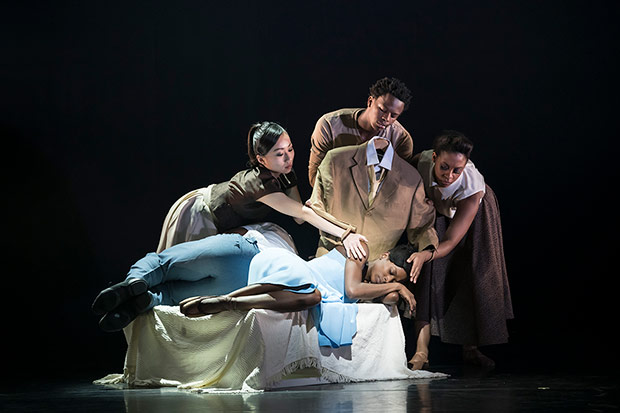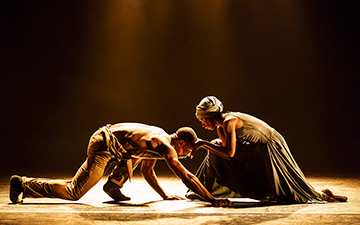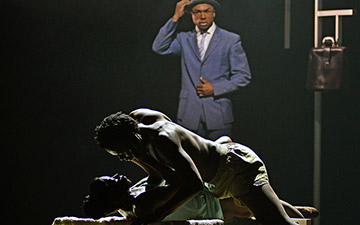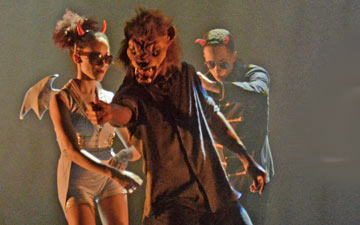
© Bill Cooper. (Click image for larger version)
Ballet Black
The Suit, Ingoma
★★★★✰
London, Linbury Theatre
13 June 2019
balletblack.co.uk
www.roh.org.uk
As it approaches the maturity of its twentieth year, Ballet Black has returned to the place that assured a paradigm shift in its early development. After seeing a pioneering show at Holborn’s Cochrane Theatre, Deborah Bull (then) creative director of ROH2 – pursuing artistic initiatives for the Royal Opera House’s smaller venues – invited Ballet Black to Covent Garden, in 2003. As well as utilising dance studios at weekends, and enjoying Associate company status, regular performances were held in the Clore Studio and the Linbury.
The House’s recent refurbishment has meant a four-year absence, during which time Ballet Black has moved into a new studio in Marylebone, finally gained Arts Council funding and adopted the Barbican Theatre as its main London performance base.
This brief season at the refurbished Linbury Theatre was something of a sentimental homecoming, showcasing the company’s two recent major commissions: The Suit, by in-demand choreographer, Cathy Marston; and Ingoma, a debut choreographic opportunity for company dancer, Mthuthuzeli November. Merging these two works onto the same bill created a powerful double-header of impressive and arresting dance theatre.
The Suit won two National Dance Awards in 2018: for best classical choreography and outstanding male classical performance (José Alves). Alves reprised his role as Philemon, who having left for work, realises that he has forgotten his briefcase, and returning home, discovers his wife in flagrante with another man. The lover (November) departs farce-style, through a window wearing just his boxer shorts, leaving behind his suit, shirt and tie. Thereafter, Philemon routinely humiliates his wife, Matilda, by making her treat these clothes, arranged on a frame, as a house guest, dining with it and making her dance with the unembodied clothing in public.
Marston deserves all the plaudits for this little gem of a ballet, not least because of its succinct narrative clarity. With a minimal, moveable set – ingeniously designed by Jane Heather – the movement of just a few items together with the structural arrangement of performers makes the audience genuinely believe in a bedroom, a bathroom – with mirrors that don’t exist – a busy street, a bus-stop and a park. It is a splendid collaborative achievement, linking design and choreography into impactful storytelling, for which Edward Kemp’s contribution as dramaturg deserves credit. The eclectic mix of music by the Kronos Quartet in association with Phillip Feeney brings layers of additional emotional resonance to this tragic story.
Sayaka Ichikawa delivered a sensational performance as Matilda, from the sensual embrace with her lover – an erotic effect that was doubly impressive when they were lying on a “bed” assimilated from the side-slats of wooden chairs – to the panic of their discovery and on through her degrading humiliation. It was an exceptional dramatic tour de force. Alves also again impressed in his downward spiral as the cuckolded husband: at first, a kindly gentleman who helps old ladies cross the street, before his heart is turned to stone by the shock of Matilda’s infidelity.
It is remarkable how the small group of dancers surround the principals with support through the tireless background work of Isabela Coracy, Marie-Astrid Mence, Cira Robinson and Ebony Thomas, each fulfilling a host of quick-change roles; and, after his brief but sizzling cameo as the lover, even November slips back into the anonymity of the ensemble.

© Mthuthuzeli November. (Click image for larger version)
I was much more taken with Ingoma than I had been, earlier this year, at the Barbican, where it had seemed distant and unengaging. Here, at the Linbury, it may as well have been a different production, where a closer and more central perspective made it striking. The other significant difference was the sudden reveal of November himself as the other six dancers peel away (he had not performed at the Barbican). The inspiration for his first major choreography is deeply personal, drawing from a painting and a poem, both fuelled by poignancy and anger at the treatment of striking mine workers in November’s homeland of South Africa.
Opening with the house lights up, the mine setting was overtly described by the dancers in wellington boots, overalls and mining hats with lamps alight, dragging bags across the stage to create effective imagery of toil. November becomes a cipher for the striking miners in a coruscating, breath-taking solo of relentless physicality, stamping and gesturing until exhausted. There is also a poignant, heartfelt duet with Robinson, essaying both vulnerability and strength in a mutual bond that is reinforced by the many and varied ways in which the couple touch; and a final yearning solo for Mence. David Plater’s lighting emphasised the work’s impact, alongside Yann Seabra’s designs and the bespoke score by Peter Johnson.
I don’t recall Ballet Black ever previously mounting a work with an African theme but it is nonetheless primarily a work of neoclassical ballet, and although the women begin in wellingtons, these are soon swapped for pointe shoes. Following an award-winning success by a hugely experienced choreographer, it is a great credit to newbie November that his debut work stood up as an equally satisfying other half of this powerful and entertaining double bill.
















You must be logged in to post a comment.